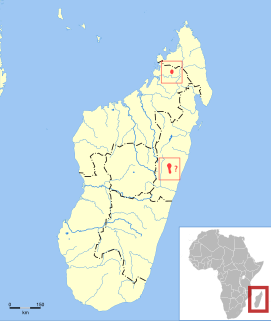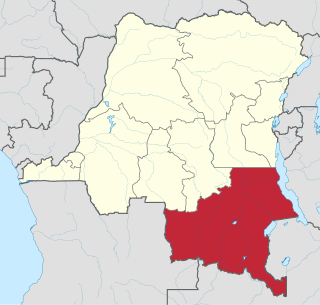
The Sumatran water shrew is a red-toothed shrew found only in the Padang highlands of western Sumatra, Indonesia. Its natural habitats are streams in montane forests. The species is only known from a holotype, which is damaged, and was previously listed as critically endangered by IUCN. It is believed to be severely threatened by habitat loss.

Acalypha rubrinervis is an extinct plant in the spurge family (Euphorbiaceae), from the island of Saint Helena in the South Atlantic Ocean. It was called string tree on account of the thin pendulous inflorescences which resembled red strings. Disturbance following human settlement on the island destroyed its habitat and it was last seen in the 19th century. It is thus one of a number of island plants to have been driven to extinction by human activity.

Pohle's fruit bat is a near threatened species of megabat found in the subtropical or tropical forests of Cameroon, the Republic of Congo, Côte d'Ivoire, Ghana and Liberia.
The limestone rat is a species of rodent in the family Muridae found only in the limestone karsts of Saraburi, Lopburi, Nakhon Sawan provinces, central Thailand. It is listed as an endangered species due to its highly fragmented limestone karst habitat that is currently threatened by mining.

The Tonkean black macaque or Tonkean macaque is a species of primate in the family Cercopithecidae. It is endemic to central Sulawesi and the nearby Togian Islands in Indonesia. It is threatened by habitat loss. Widespread mining in central Sulawesi is believed to exacerbating the problems of habitat loss.

The Choco broad-nosed bat is a species of bat in the family Phyllostomidae. It is native to Colombia, Panama, and Ecuador, where it is found in the Choco region lowlands. It is threatened by habitat loss. In 2013, Bat Conservation International listed this species as one of the 35 species of its worldwide priority list of conservation.

The Aldabra flying fox is a species of megabat in the genus Pteropus. It is endemic to the Aldabra Atoll in the Seychelles, like Chaerephon pusilla, though the latter may be the same species as the little free-tailed bat.

The ashy-headed flying fox or North Moluccan flying fox is a species of bat in the family Pteropodidae. It is endemic to Indonesia.

The Hills' horseshoe bat is a species of bat in the family Rhinolophidae. It is found in Cameroon, Guinea, Liberia, and Nigeria. Its natural habitats are subtropical or tropical moist lowland forest, subtropical or tropical moist montane forest, caves, and subterranean habitats. It is threatened by habitat loss.
Acalypha ecuadorica is a species of plant in the family Euphorbiaceae. It is endemic to Ecuador. Its natural habitat is subtropical or tropical dry forests.
Acalypha eggersii is a species of plant in the family Euphorbiaceae. It is endemic to Ecuador. Its natural habitat is subtropical or tropical dry forests.
Acalypha hontauyuensis is a species of plant in the family Euphorbiaceae. It is a shrub endemic to Orchid Island, Taiwan. The Flora of China, however, lists it as a synonym of Acalypha suirenbiensis from the Taiwanese mainland.
Acalypha suirenbiensis is a species of plant in the family Euphorbiaceae. It is endemic to Hualien County, Taiwan. The Flora of China, however, includes Acalypha hontauyuensis from Orchid Island in this species. It is a shrub growing about 3 m (10 ft) tall.
Acalypha tunguraguae is a species of plant in the family Euphorbiaceae. It is endemic to Ecuador. Its natural habitat is subtropical or tropical moist montane forests.
Bat Conservation International (BCI) is an international nongovernmental organization working to conserve bats and their habitats through conservation, education, and research efforts.

The northern shrew tenrec is a species of mammal in the family Tenrecidae. It is endemic to Madagascar, where it has a restricted disjoint range in two locations 485 km apart in the north and east of the island. In the north, it is found on the southwestern slopes of the Tsaratanana Massif at elevations from 1420 to 1680 m. In central eastern Madagascar, it is found in the Ambatovy Forest. Its natural habitat is montane forest. The species is most closely related to the widely distributed M. cowani. This tenrec is threatened by deforestation from agricultural conversion, lumbering and mining.

Acalypha dikuluwensis was a 25 centimetres (9.8 in) high tropical flowering plant in the genus Acalypha of the family Euphorbiaceae. The IUCN Red List of Threatened Species declared the plant extinct in 2012. A. dikuluwensis was endemic to copper-rich soils of eastern Katanga Province of the Democratic Republic of the Congo, and was only found around Dikuluwe. The soils are derived from Katanga Supergroup Upper Cambrian Roan Group rocks. It was restricted to steppic savanna in copper outcrops, which were destroyed by surface mining. No specimens were found after 1959.
Acalypha wilderi was a species of spurge that was only known from forested habitats along the northern and western sides of Rarotonga in the Cook Islands, at elevations of 200–300 m. Very little is known about this species, but collections suggest it was a small shrub rarely exceeding 2 m in height. Its habitat has been greatly modified for agriculture, roads, housing, plantations and invasive species, and has not been seen since 1929, and was declared extinct in 2014. This species may be synonymous with A. raivavensis and A. tubuaiensis.
Aeollanthus saxatilis is a species of plant in the mint family, Lamiaceae. It is endemic to the Katangan Copperbelt in Katanga Province, Democratic Republic of the Congo. It is an absolute metallophyte, living on rocky steppes with copper-rich soils. It is threatened by surface mining activities.










